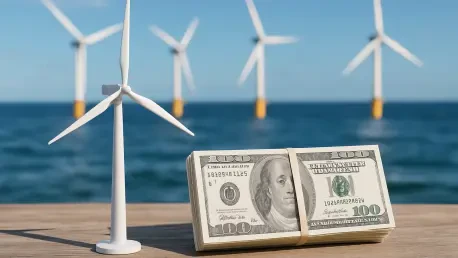Imagine a nation at a critical crossroads, where a single policy decision could reshape its energy landscape for decades, and the recent revocation of $679 million in federal funding for offshore wind infrastructure by the Trump administration has ignited fierce debate across political, economic, and environmental spheres. This staggering cut, affecting 12 major projects, has left stakeholders scrambling to understand its implications. This roundup dives into a collection of opinions, insights, and analyses from various sources, including state leaders, industry experts, and policy analysts, to explore why this decision was made, what it means for the future of renewable energy in the U.S., and how it reflects broader ideological divides. The purpose is to present a balanced view of this pivotal moment in energy policy, comparing contrasting perspectives to shed light on the stakes involved.
Diving into the Policy Shift: Why the Cut Happened
Administration’s Rationale: Prioritizing Traditional Energy
Insights gathered from policy analysts close to the Trump administration reveal a clear intent to steer national resources away from renewable energy initiatives like offshore wind. The focus, as articulated by federal officials, is on bolstering traditional energy sectors and industries such as shipbuilding, which are seen as more aligned with immediate economic and energy independence goals. Statements from the U.S. Department of Transportation emphasize reallocating funds to infrastructure needs deemed more critical, framing offshore wind as a less urgent priority.
This perspective highlights a belief that federal investments should target sectors with proven economic returns over experimental or long-term projects. Analysts note that projects like the Humboldt Bay Terminal, which lost $426.7 million in funding, are viewed as misaligned with the administration’s vision. This stance has sparked discussions about whether short-term industrial gains are being favored at the expense of sustainable energy development.
A contrasting undercurrent among some federal policy observers suggests that this move may also be politically motivated, appealing to constituencies that prioritize fossil fuel industries. While the administration insists on economic pragmatism, critics argue that this redirection risks sidelining the U.S. in the global race for clean energy innovation. The tension between these views underscores a fundamental clash in national priorities.
State Leaders’ Opposition: A Blow to Progress
Democratic governors from coastal states have voiced strong dissent against the funding cut, offering a sharply different take on its consequences. Leaders from states like New York and Massachusetts argue that revoking support for offshore wind undermines years of planning and investment in renewable energy. Their collective stance, expressed through joint statements, warns of jeopardized job creation and economic growth in regions banking on these projects.
Specific concerns center on stalled initiatives like the Sparrows Point Steel Marshalling Port in Maryland, which lost $47.3 million in federal support. State officials highlight the ripple effects on local communities, where anticipated jobs and infrastructure upgrades are now in limbo. This perspective paints the federal decision as a betrayal of regional interests, prioritizing ideological goals over tangible economic benefits.
Beyond immediate losses, these leaders express alarm over the message this sends to private investors. The unpredictability of federal policy, they contend, could deter future funding, raise costs for remaining projects, and burden taxpayers. Their frustration reveals a deep divide between state and federal visions for energy policy, setting the stage for potential legal or political battles.
Economic and Environmental Impacts: Stakeholder Insights
Industry Experts on Economic Fallout
Feedback from industry professionals in the renewable energy sector points to significant economic repercussions following the funding revocation. Many emphasize that the sudden halt of projects disrupts supply chains and workforce planning, particularly in coastal areas heavily invested in offshore wind. The loss of federal support for initiatives like the Arthur Kill Terminal in New York, previously allocated $48 million, is seen as a direct hit to local economies.
Beyond immediate job losses, there’s a broader concern about investor confidence. Business leaders in the sector caution that erratic policy shifts create a risky environment for private capital, potentially stalling future developments. Some estimate that financing costs could rise as lenders factor in heightened uncertainty, ultimately impacting the affordability of renewable energy projects.
A differing viewpoint from economic analysts sympathetic to the administration’s goals suggests that reallocating funds to traditional industries might yield quicker returns. They argue that sectors like shipbuilding could provide stable employment faster than offshore wind, though this opinion is contested by those who see renewables as a long-term economic driver. This split in expert analysis highlights the complexity of balancing short-term gains with future-focused investments.
Environmental Advocates on Climate Setbacks
Environmental groups and sustainability experts offer a grim assessment of the funding cut’s impact on climate goals. Many assert that scaling back offshore wind, a key component of carbon reduction strategies, slows national progress toward cleaner energy systems. They point to the broader policy rollbacks, including stop-work orders on projects like Revolution Wind, as evidence of a retreat from environmental commitments.
A nuanced perspective from some analysts suggests that this decision could inadvertently push innovation in other renewable sectors, such as solar or onshore wind, as stakeholders seek alternatives. However, the dominant concern remains that reliance on fossil fuels may deepen, undermining global efforts to curb emissions. The environmental community largely views this as a missed opportunity to maintain U.S. leadership in sustainable energy.
Contrasting opinions from energy policy think tanks aligned with traditional energy sectors argue that the environmental impact of offshore wind is overstated. They contend that the technology’s current inefficiencies and high costs make it a less practical solution compared to existing energy sources. This debate reveals a stark divide in how different groups weigh ecological priorities against economic realities.
Global Standing and Future Policy: Broader Opinions
International Competitiveness: Falling Behind?
Commentary from global energy market observers raises alarms about the U.S. position in the international renewable energy race. Many note that European nations continue to advance offshore wind at a rapid pace, with robust government backing and private investment. The decision to defund $679 million in U.S. projects is seen as a step backward, potentially ceding ground to competitors who prioritize clean energy infrastructure.
Some international policy experts suggest that this move could weaken partnerships with allies who view renewable energy as a shared priority. The perception of policy instability may also discourage foreign companies from engaging in U.S. energy projects, limiting access to cutting-edge technology. This angle introduces a geopolitical dimension to the funding cut, often overlooked in domestic debates.
A smaller faction of analysts argues that focusing on domestic traditional energy could strengthen energy security, reducing reliance on global supply chains. While this view acknowledges short-term benefits, it is largely overshadowed by concerns about long-term competitiveness. The consensus among global observers leans toward the idea that renewable energy leadership is critical for maintaining economic and diplomatic influence.
Policy Trends and Future Battles
Insights from political analysts indicate that the funding cut is part of a larger pattern of dismantling renewable energy support, including import investigations and lease cancellations. This trend suggests a sustained push to reshape energy policy over the coming years, with coastal states likely to bear the brunt of these changes. Observers predict heightened friction between federal and state governments as a result.
Some policy watchers propose that states might counteract federal cuts by seeking alternative funding sources, such as public-private partnerships or state-level grants. This approach, while promising, faces hurdles in scale and coordination, according to regional planners. The potential for innovative financing models offers a glimmer of hope amid widespread uncertainty.
A divergent opinion from federal policy advocates maintains that streamlining resources toward traditional sectors aligns with voter priorities in key regions. Yet, this view is challenged by predictions of escalating legal challenges from states determined to protect their renewable investments. These contrasting forecasts point to a contentious road ahead for U.S. energy policy, with offshore wind at the heart of the struggle.
Reflecting on the Roundup: Key Takeaways and Next Steps
Looking back, this exploration of diverse perspectives on the $679 million offshore wind funding cut uncovered a profound ideological rift between renewable and traditional energy priorities. State leaders lamented the economic and environmental setbacks, while industry experts highlighted risks to investment and innovation. Environmental advocates decried the potential climate impact, and global observers warned of diminished U.S. competitiveness. Meanwhile, administration-aligned voices defended the pivot as a pragmatic reallocation of resources.
Moving forward, stakeholders are encouraged to explore alternative funding mechanisms at the state level to sustain offshore wind projects. Advocacy for federal-state collaboration could help bridge the policy divide, ensuring that regional needs are addressed. Readers and policymakers alike might consider delving deeper into local renewable initiatives or tracking upcoming legislative debates to stay engaged with this evolving issue. The path ahead demands creative solutions and persistent dialogue to balance immediate economic needs with the imperative of a sustainable energy future.









